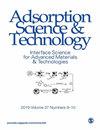香灰新型富钙沸石结构研究及其废水处理应用的实验与计算方法
IF 2.8
4区 工程技术
Q2 CHEMISTRY, APPLIED
引用次数: 13
摘要
目前,化学硅铝源主要用作制造沸石的前驱体材料。这种前驱体材料用于商业合成是相当昂贵的。本文首次报道了以香灰废料为原料,采用碱法合成钙基沸石。以香灰(ISA)为前驱体,采用碱法合成低硅沸石。采用粒度分析仪(PSA)、傅里叶变换红外(FTIR)、x射线衍射(XRD)、场发射扫描电镜(FESEM)、电子衍射光谱(EDS)、透射电子显微镜(TEM)和x射线荧光(XRF)等仪器对合成的沸石进行了表征。FTIR和XRD对分子筛的微观结构和结晶性质进行了表征,同时也证实了在25.7°处合成了2 θ的ca基分子筛。FESEM和TEM显微分析表明,合成的富钙沸石粒径在200 ~ 700 nm之间,呈聚集状,呈立方状。此外,通过计算模拟(第一原理、密度泛函定理)评价了gismondine (Ca2Al4Si4O16·9H2O)结构的结构、电子和态密度特征。在晶格常数的总能量和作用于原子的力最低的条件下,结合现有的实验和理论发现,对结构进行了结构优化。本研究方法预测了ISA废物转化为增值矿物沸石,并利用电感耦合等离子体光学发射光谱(ICP-OES)进一步用于去除粉煤灰废水中的重金属和碱金属。本文章由计算机程序翻译,如有差异,请以英文原文为准。
Experimental and Computational Approaches for the Structural Study of Novel Ca-Rich Zeolites from Incense Stick Ash and Their Application for Wastewater Treatment
At present, chemical Si/Al sources are mainly used as precursor materials for the manufacturing of zeolites. Such precursor materials are quite expensive for commercial synthesis. Here, we have reported the synthesis of Ca-based zeolite from incense stick ash waste by the alkali-treatment method for the first time. Incense stick ash (ISA) was used as a precursor material for the synthesis of low Si zeolites by the alkali-treatment method. The as-synthesized zeolites were characterized by various instruments like particle size analyzer (PSA), Fourier transform infrared (FTIR), X-ray diffraction (XRD), field emission scanning electron microscope (FESEM), electron diffraction spectroscopy (EDS), transmission electron microscopy (TEM), and X-ray fluorescence (XRF). FTIR and XRD helped in the identification of the microstructure and crystalline nature of the zeolites and also confirmed the synthesis of Ca-based zeolite with two thetas at 25.7°. The microscopic analysis by FESEM and TEM exhibited that the size of synthesized Ca-rich zeolites varies from 200 to 700 nm and they are aggregated and cuboidal in shape. Additionally, structural, electronic, and density of states’ characteristics of gismondine (Ca2Al4Si4O16·9H2O) structures were evaluated by computational simulations (first principle, density functional theorem). The structural optimization of structures was carried out in the first stage under the lowest condition of total energy and forces acting on atoms for the lattice constant, as well as the available experimental and theoretical findings. The present research approach predicted the transformation of ISA waste into a value-added mineral, i.e., zeolite, which was further used for the removal of both heavy metals and alkali metals from fly ash-based wastewater using inductively coupled plasma-optical emission spectroscopy (ICP-OES).
求助全文
通过发布文献求助,成功后即可免费获取论文全文。
去求助
来源期刊

Adsorption Science & Technology
工程技术-工程:化工
CiteScore
5.00
自引率
10.30%
发文量
181
审稿时长
4.5 months
期刊介绍:
Adsorption Science & Technology is a peer-reviewed, open access journal devoted to studies of adsorption and desorption phenomena, which publishes original research papers and critical review articles, with occasional special issues relating to particular topics and symposia.
 求助内容:
求助内容: 应助结果提醒方式:
应助结果提醒方式:


